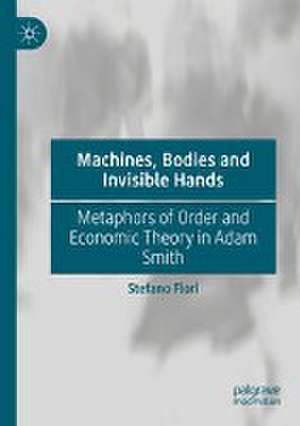Machines, Bodies and Invisible Hands: Metaphors of Order and Economic Theory in Adam Smith
Autor Stefano Fiorien Limba Engleză Paperback – 25 oct 2022
The content and scope of the book permits a more comprehensive interpretation of Smith’s thought, in which many aspects of his work are taken into consideration in order to explain a crucial problem for Smith: the nature and causes of social and economic order. The book also shows that in general, formation of theories is a complex process that includes pre-analytical views as non-residual parts of inquiry.
| Toate formatele și edițiile | Preț | Express |
|---|---|---|
| Paperback (1) | 692.88 lei 6-8 săpt. | |
| Springer International Publishing – 25 oct 2022 | 692.88 lei 6-8 săpt. | |
| Hardback (1) | 699.28 lei 6-8 săpt. | |
| Springer International Publishing – 24 oct 2021 | 699.28 lei 6-8 săpt. |
Preț: 692.88 lei
Preț vechi: 815.16 lei
-15% Nou
Puncte Express: 1039
Preț estimativ în valută:
132.59€ • 139.06$ • 110.37£
132.59€ • 139.06$ • 110.37£
Carte tipărită la comandă
Livrare economică 01-15 aprilie
Preluare comenzi: 021 569.72.76
Specificații
ISBN-13: 9783030852085
ISBN-10: 3030852083
Pagini: 242
Ilustrații: IX, 242 p.
Dimensiuni: 148 x 210 mm
Greutate: 0.31 kg
Ediția:1st ed. 2021
Editura: Springer International Publishing
Colecția Palgrave Macmillan
Locul publicării:Cham, Switzerland
ISBN-10: 3030852083
Pagini: 242
Ilustrații: IX, 242 p.
Dimensiuni: 148 x 210 mm
Greutate: 0.31 kg
Ediția:1st ed. 2021
Editura: Springer International Publishing
Colecția Palgrave Macmillan
Locul publicării:Cham, Switzerland
Cuprins
Chapter 1. Introduction.- Part 1. Machines, Bodies, and Invisible Hands.- Chapter 2. Metaphors as conceptual tools.- Chapter 3. The metaphor of the machine.- Chapter 4. Smith and the organic metaphors.- Chapter 5. The invisible hand.- Part 2. Visible and Invisible Orders: The Secrets of Organization.- Chapter 6. Paradigms of Order in the Seventeenth Century: Intelligibility as Visibility.- Chapter 7. The Invisible Order: Imagination, Nature, and the Economic Sphere.- Chapter 8. Organization and Invisible Forces in the Life Sciences of the Late Eighteenth Century.- Part 3. Forms and Experiences of Time.- Chapter 9. Time and Social Order.- Chapter 10. Conclusions.
Notă biografică
Stefano Fiori teaches economics in the Department of Economics and Statistics “Cognetti de Martiis” University of Torino, Italy. His research fields focus on the history of economic thought and on the connection between philosophy, economics, and other social sciences, viewed in historical perspective. His scientific interests include pre-classical and classical economics, Austrian economics, institutional and new institutional economics, economic methodology, and theories of bounded rationality.
Textul de pe ultima copertă
What was Adam Smith’s intellectual laboratory? How did his economic theory take shape? Were his metaphors of order only residual and ornamental expressions? This book answers these questions by analyzing the formation of the concepts of market and social order in Adam Smith’s work, by considering various aspects of his approach. It analyzes how metaphors and pre-analytical concepts influenced Smith’s theory. In line with studies that deal with the cognitive role of metaphors in science, this book suggests that in Smith’s work metaphors provided a framework, on which basis the theory subsequently developed. Therefore, as such they were part of that intellectual process which made possible the formation of structured concepts.
The content and scope of the book permits a more comprehensive interpretation of Smith’s thought, in which many aspects of his work are taken into consideration in order to explain a crucial problem for Smith: the nature and causes of social and economicorder. The book also shows that in general, formation of theories is a complex process that includes pre-analytical views as non-residual parts of inquiry.Stefano Fiori teaches economics in the Department of Economics and Statistics “Cognetti de Martiis” University of Torino, Italy. His research fields focus on the history of economic thought and on the connection between philosophy, economics, and other social sciences, viewed in historical perspective. His scientific interests include pre-classical and classical economics, Austrian economics, institutional and new institutional economics, economic methodology, and theories of bounded rationality
The content and scope of the book permits a more comprehensive interpretation of Smith’s thought, in which many aspects of his work are taken into consideration in order to explain a crucial problem for Smith: the nature and causes of social and economicorder. The book also shows that in general, formation of theories is a complex process that includes pre-analytical views as non-residual parts of inquiry.Stefano Fiori teaches economics in the Department of Economics and Statistics “Cognetti de Martiis” University of Torino, Italy. His research fields focus on the history of economic thought and on the connection between philosophy, economics, and other social sciences, viewed in historical perspective. His scientific interests include pre-classical and classical economics, Austrian economics, institutional and new institutional economics, economic methodology, and theories of bounded rationality
Caracteristici
Develops an original analysis of how Smith used metaphors as theoretical tools Compares Smith’s metaphors and metaphors used in the seventeenth century Examines the epistemological turn that occurred in Smith’s political economy in the last decades of the 18th century
